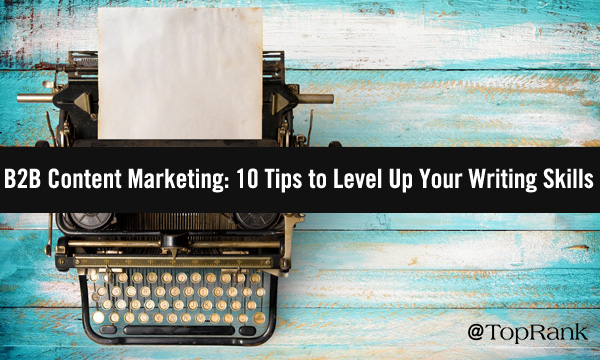
What is the biggest challenge a writer faces?
Nothing.
Well, by “nothing,” I mean a blank white screen and a blinking cursor.
It mocks you with its unlimited potential. It fills you with fear that anything you put on that screen won’t be an improvement over its pristine emptiness.
We content marketers have to face this challenge nearly every day, and somehow find a way to write content that connects, engages, and persuades.
I’ve spent my entire adult life working in the content trenches — first as a comedy writer, and now as a content marketer. Here are a few tips I’ve picked up that can elevate your writing and make that blank screen less daunting.
10 Tips for B2B Marketers to Elevate Their Writing Skills
#1: READ
In his excellent book On Writing, Stephen King says: “If you don’t have time to read, you don’t have time to write.” And if one of the world’s most prolific and celebrated authors can take time to read, we can, too.
Read marketing content, for sure, to see what the competition is up to. But don’t stop there. Read poems, novels, fiction, nonfiction, good stuff and guilty pleasures. Anything you read will help you continue to develop a distinct voice — even a bad example can show you what not to do.
#2: Be Aware of Rhythm
Now, I’m not saying you should write blog posts in iambic pentameter (but if you do, please link me). But it’s good to keep an eye on the rhythm of what you’re writing.
For example, watch out for parallel structures. In time, these will bore your reader. Soon enough, they’ll tune out completely.
Notice how all three of those sentences in the last paragraph have the same cadence? The same goes for short sentences. You put them one after the other. They’re all the same.
Vary the rhythm in your sentences — string them together with punctuation; let one stretch out like a rubber band. Then, snap! Put in a few short ones. Maybe a fragment, even. See how the writing comes alive?
#3: Practice Introductions
For many writers, just getting started is the hardest part of writing an article. Many will even write the entire body of the text and add the introduction after the fact.
Too many of us were scarred by high school English class, where an introduction had to introduce every point we were going to talk about, and had to start with something like, “Throughout recorded history,” or “Webster’s dictionary defines…”
Practice writing introductions that break the mold:
- Ask a question
- Make a controversial or otherwise intriguing statement
- Write a personal anecdote
In short, think less about introducing every talking point, and more about hooking the reader and pulling them in.
#4: Don’t Tell the Audience What They Already Know
This one goes along with the last point, because frequently introductions are all about stating the obvious. “Everyone knows that…” “We all understand that…”
Whenever you find yourself lecturing the audience on something you both know, take a step back. What can you tell them that they haven’t heard yet? What’s the quickest way to get to the good stuff?
#5: Let Go of Obsolete Rules
And speaking of high school English class: It is better to be clear, natural and genuine in your prose than to follow archaic rules of grammar. Language is a living thing that is constantly changing. So don’t feel beholden to what Mrs. Funke told you back in 9th grade.
For example:
- End sentences with prepositions
- Put commas where they feel natural
- Use sentence fragments
- Use. Weird. Punctuation. For. Emphasis!
- Embrace the singular ‘they’
And many more. Basically, you should sound like a real live person, not a textbook.
#6: Read It Out Loud
When we talk about writing in a “conversational tone,” we’re saying the writing should feel more like talking to a friend than reading something stiff and formal. What better way to make sure you’re conversational than actually reading your work out loud?
Now that we’re all in home offices instead of open-concept half cubicles, this one’s easier to do. Back in the before times, I would sometimes duck into a conference room or huddle room to read my work out loud. It’s amazing how many opportunities you’ll find to make your writing sound more natural when you’re hearing it instead of reading it.
#7: Experiment with Editing
I love the way that Google Docs saves a version history of everything I write. It makes editing so much easier, and the stakes so much lower for making major changes. You can try something, and if it doesn’t work, it’s easy to revert to the previous draft.
Experiment with the structure of your content — move paragraphs around and see if that improves the flow. Try cutting out the sentences you’re most proud of — odds are they’re the most self-indulgent and least likely to connect with your audience. Believe me, I speak from experience.
One easy way to experiment with editing: Cut the first paragraph of your introduction and see if you miss it. I frequently find that first paragraph is either wheel-spinning or scene-setting that the audience doesn’t really need.
#8: Write, Wait, Review, Revise
Writing and revising require two different mindsets. If you’re trying to do both at the same time, you’re likely not doing either as well as you might. For your first draft, concentrate on getting the words on the screen. When you’re done, walk away and let it rest — overnight, if possible.
Then you can approach what you’ve written with fresh eyes, read it through, and revise. After that, make sure to have at least one other person review it before you publish, just to catch whatever you might have missed.
“Writing and revising require two different mindsets. If you’re trying to do both at the same time, you’re likely not doing either as well as you might.” — Joshua Nite @NiteWrites Share on X#9: Spice Up Your Conclusions
Lastly, in conclusion, at the end of the day, finally… there are many ways to begin a conclusion, and most of them are (yet again) holdovers from high school. Ditto the idea that you shouldn’t introduce new information in a conclusion, but just rehash the points you’ve already made.
Thankfully, we’re not writing five paragraph essays anymore, and a conclusion can be more than an awkward recap. In fact, for marketing, it’s essential to make every conclusion a launchpad, a call to action that compels the reader to take the next step. Bland, by-the-book conclusions won’t get that job done.
Beat the Blank Screen
If you feel anxious when faced with that blank screen and its judgmental blinking cursor, start by letting go of some preconceived notions about what business writing has to be. It turns out that B2B buyers are actual people, and they would rather read something personable and expressive than something stiff and by-the-book. My tenth tip: Give yourself permission to write the way you talk, and you’re more likely to make a human connection with your reader.
Need help leveling up your content? Contact us today.



